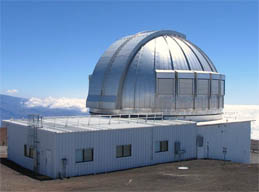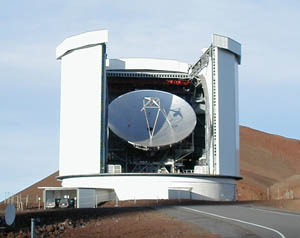Faced with too many telescopes and too little funding, U.K. officials have decided to close the country's two observatories atop Mauna Kea in Hawaii.
Today officials at the United Kingdom's Science and Technology Facilities Council announced their decision to stop funding two of the oldest observatories atop Mauna Kea in Hawaii. Unless some other organization takes over their operation, the United Kingdom Infrared Telescope (UKIRT) will cease operations in September 2013 and the James Clerk Maxwell Telescope will close a year later.
It's becoming an all-too-common scenario in an era of diminished priorities and funding for scientific endeavors. The U.K. has lined up to participate in megaprojects like the ALMA radio array in Chile, the Square Kilometer Array, and the hoped-for European Extremely Large Telescope. But those buy-ins leave little cash to maintain the country's older but still productive facilities in Hawaii and the Canary Islands.

The United Kingdom Infrared Telescope (UKIRT) is situated at the summit of Mauna Kea in Hawaii.
Joint Astronomy Centre
The STFC's decision spares the three telescopes of the Isaac Newton Group on La Palma. But UKIRT and JCMT on Mauna Kea's summit, along with the Joint Astronomy Centre in Hilo that manages them, didn't make the cut. They will either be transferred to alternate operators or decommissioned once their existing observation projects end.
The news wasn't unexpected, as STFC signaled its intentions in late 2009. But it's still a sad turn of events that has not been received well by astronomers. For UKIRT, in particular, the early closure will bring an abrupt end to a deep infrared survey that has been ongoing since 2005. Members of the UKIRT board were quick to express their disappointment, noting that the survey work could have continued for an additional year for only about $150,000. "UKIRT's productivity is at an all-time high," the board asserts, "with the number of papers published in 2011 amongst the highest of any telescope in the world."

The James Clerk Maxwell Telescope (JCMT) is the largest astronomical facility in the world designed to operate specifically in the submillimeter region of the electromagnetic spectrum.
Joint Astronomy Centre
With an aperture of 12.5 feet (3.8 m), UKIRT ranks as the world's second largest telescope dedicated solely to infrared observations (surpassed only by the recently built VISTA telescope in Chile). It was built in the late 1970s and has been operated remotely from Hilo (no observers present) for more than a year.
The James Clerk Maxwell Telescope has a primary mirror 49 feet (15 m) across, making it the largest telescope optimized for observing at submillimeter (far-infrared to microwave) wavelengths. Built by the U.K., Canada, and the Netherlands, JCMT saw first light in 1987.
What's transpiring in the U.K. could well be a harbinger of equally unwelcome events on this side of the Atlantic. A panel of U.S. astronomers has just about concluded a "portfolio review" for the National Science Foundation, and when the group releases its findings in a few months, many expect that legendary facilities such as Kitt Peak National Observatory might likewise face closure.
 10
10









Comments
Bruce
June 1, 2012 at 6:23 am
This wouldn't be as hard to read about if these facillities where obsolete, but a Kelly Beatty reports they are both still at or near the top of the field in they're respective parts of the spectrum. We'll always want bigger telescopes, but at the cost of closing perfectly good ones?
You must be logged in to post a comment.
Haldun I. Menali
June 1, 2012 at 12:55 pm
This is really so sad to hear. Especially after knowing that these two are actively working and successful scientific research centers. At the end, it all comes to choices: choice between spending government budgets in unnecessary wars and destruction (arms race, nuclear proliferation, etc.), and advancement of human knowledge, science and understanding of mankind's place in the universe. If the general public and scientists rally against the defense industry, and push them to choose investing into astronomical and astronautical sciences instead of producing weapons of mass destruction, we can win this fight. Paraphrasing the motto from 1960's: "Make science, not war"!
Just imagine......
Haldun I. Menali
Bank Executive and Amateur Astronomer
Boston, MA
You must be logged in to post a comment.
George Kasica
June 1, 2012 at 1:59 pm
You're jodes right? With budgets on both sides of the Atlantic for many NSF and UK projects in the multi-MILLIONS of $$ they couldn't find $150K? THAT is really sad and depressing state of affairs.
Anyone want to start a fund to raise the $$ and keep the sites open? $100 from 1500 people or $50 from 3000 gets it done.
As to Kitt Peak, verry distress ing - myself, parents and wife have traveled to near Tucson AZ to see it many times since I was a child (now 46). As far as I know the Solar Telescope therewhat is still unique in what it offers nowhere else in the US and possibly worldwide. Shuttering that seems to border on stupidlty.
Just my 2 cents,
George
You must be logged in to post a comment.
Mike W. Herberich
June 1, 2012 at 3:17 pm
Why not start fund raising here and now, possibly with the support of Sky & Telescope? I ([email protected]) herewith guarantee to pay my $100 to anyone organizing this sufficiently trustably. Also, how about approaching wealthy people/ companies, starting from Bill Gates downward (especially banks, maybe: to brush up their currently hampered images!) for THE/ just A contribution, in exchange for their ads and publicity somewhere around this issue? Just a thought/ suggestion/ encouragement.
You must be logged in to post a comment.
Haldun I. Menali
June 1, 2012 at 4:08 pm
I wholeheartedly support Mike's suggestion...... my $100 is ready when this is organized. And I also agree that more-than-well-to-do individuals and corporations should be "encouraged" to give more support to scientific projects, not only one time, but through a special science-support tax (something less than 0.05% of their annual profits over, say 100M would do) that would go directly to the National Science Foundation in the US and their counterparts in other industrialized nations. We need more of Lick's, Keck's, Eberly's, Yerkes's and the like these days to keep science moving ahead.
Haldun I. Menali.
You must be logged in to post a comment.
craig porter
June 2, 2012 at 2:01 am
Dark matter is too sensitive to detect in normal laboratories, but one so far underground would help shield it from pesky cosmic radiation. Also, the LUX detector is submerged in water, further insulating it.
Gaitskell said he’s worked with 70 scientists and 14 institutions over the past four years to finally make the LUX experiment a reality.
That detector will be in the Davis Campus, named after Ray Davis, who won a Nobel Prize for Physics for an experiment he started in 1965 inside the then-working mine. Nearby in a new hall called the Transition Area will be the Majorana Demonstrator Experiment. That’s aimed to search for a rare form of radioactive decay, which could help physicists understand how the universe evolved.
Experiments are set to begin this year, Harlan said. All told, the site has cost more than $300 million — a mix of private donations and state and federal funding. Among the contributors: a $10 million Housing and Urban Development grant, $40 million from the South Dakota Legislature and $70 million from philanthropist T. Denny Sanford.
You must be logged in to post a comment.
craig porter
June 2, 2012 at 2:01 am
Dark matter is too sensitive to detect in normal laboratories, but one so far underground would help shield it from pesky cosmic radiation. Also, the LUX detector is submerged in water, further insulating it.
Gaitskell said he’s worked with 70 scientists and 14 institutions over the past four years to finally make the LUX experiment a reality.
That detector will be in the Davis Campus, named after Ray Davis, who won a Nobel Prize for Physics for an experiment he started in 1965 inside the then-working mine. Nearby in a new hall called the Transition Area will be the Majorana Demonstrator Experiment. That’s aimed to search for a rare form of radioactive decay, which could help physicists understand how the universe evolved.
Experiments are set to begin this year, Harlan said. All told, the site has cost more than $300 million — a mix of private donations and state and federal funding. Among the contributors: a $10 million Housing and Urban Development grant, $40 million from the South Dakota Legislature and $70 million from philanthropist T. Denny Sanford.
You must be logged in to post a comment.
Anthony Barreiro
June 3, 2012 at 3:13 am
I hope somebody will start a campaign on kickstarter.com or another crowd funding site to raise operating expenses for these telescopes. I'm good for $100, especially if they name some distant galaxy after me.
You must be logged in to post a comment.
Bruce
June 3, 2012 at 12:37 pm
If a Tony wants to pony up dinero,
Then search the New Galactic Catalog,
To find an M104 analog,
And call it Anthony Barreiro’s sombrero,
Olay!
Seriously, I think Anthony’s idea has great potential. Most of us readers of S&T likely have scoffed at the “name a star after someone” enterprise. But to have an entire GALAXY named after you, wow, now we’re talking. You could price galaxies by apparent diameters. Small donations would get you, say, a mere speck on the Hubble Deep Field. To reach the full yield of this fund raising tool one would need to link it with one or more of the popular sky mapping programs, so that when pointing to the galaxy, the purchased name would appear. Much better than securing your name away in a vault were no one can see it. 🙂
You must be logged in to post a comment.
Russ
September 4, 2012 at 2:02 pm
As the article states: "It's becoming an all-too-common scenario in an era of diminished priorities and funding for scientific endeavors."
"All-too-common" Why ? "An era of diminished priorities and funding for scientific endeavors." What is that supposed to mean ? Diminished priorities ? Diminished for...? SCIENTIFIC ENDEAVORS !!!
That is the crux of it. And astronomy is NOT the only area of science that is being axed - regularly ! Our original Shuttle was axed in favor of the cheapest, Frankensteined thing we flew. The original would have re-written our manned space program. Even the Saturn V was being axed as early as 1965. I have the old, original Sky & Tel where it was mentioned.
The SSC - it would have dwarfed CERN. Axed. There is way too much to list, but many of us know at least parts of the very long list. And much more is coming ! The NSF certainly isn't doing anything to help. They & the 'Augustine' committee.
You must be logged in to post a comment.
You must be logged in to post a comment.